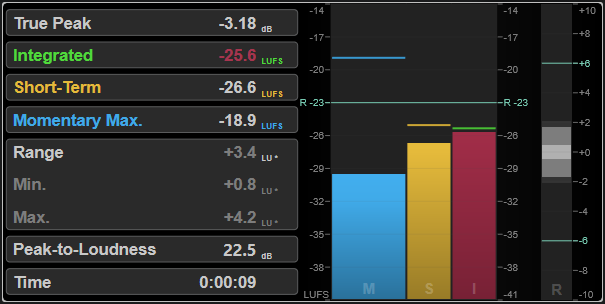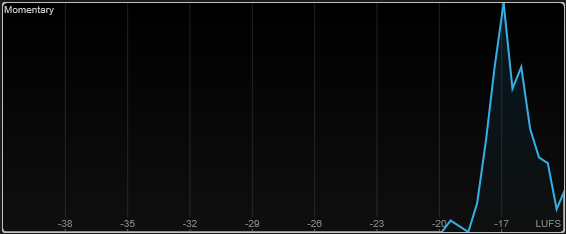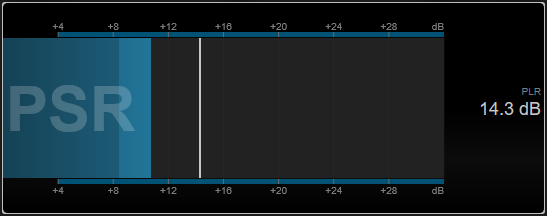Measurement Modules
The modules in this category allow you to measure the loudness and intelligibility of the audio signal.
The following modules and module-specific settings are available:
Loudness
This module shows the loudness of your audio in LU (Loudness Units) or LUFS (Loudness Units referenced to Full Scale) according to EBU R 128.

- TP (True Peak)
-
Shows the maximum true peak level in dB.
- I (Integrated)
-
Shows the integrated loudness value. This is the average loudness value that is measured over the whole audio range in LU or LUFS.
- S (Short-Term)
-
Shows the short-term loudness value that is measured every second on an audio block of 3 seconds in LU or LUFS. This gives information about the loudest audio passages.
- M Max. (Momentary Max.)
-
Shows the maximum value of all momentary loudness values that are measured every 100 ms in an audio range of 400 ms in LU or LUFS.
- R (Range)
-
Shows the loudness range (LRA) that is measured over the whole audio range in LU.
The loudness range reports the ratio between the loudest and the quietest non-silent sections. The audio is divided into small blocks. There is one audio block every second and each block lasts 3 seconds, so that the analyzed blocks overlap. The top 10 % of the quiet blocks and the top 5 % of the loud blocks are excluded from the final analysis. The calculated loudness range is the ratio between the loudest and quietest remaining audio blocks. This measurement helps you to decide how much compression or expansion must be applied to the audio.
An asterisk (*) after a loudness range value indicates that less than 1 minute of audio was analyzed.
Min. shows the minimum loudness range value in LU. Max. shows the maximum loudness range value in LU.
NoteEBU R 128 does not recommend loudness range measurement for audio shorter than 1 minute due to too few data points.
- PLR (Peak-to-Loudness)
-
Shows the peak-to-loudness ratio (PLR), also referred to as the crest factor, which is the difference between the maximum true peak level value and the integrated loudness value.
- Time
-
Shows the overall duration of the loudness measurement.
The following module-specific settings are available in the Module Settings window:
- Unit
-
Allows you to switch the meter scale between LUFS (absolute values) and LU (relative values).
- Scale
-
Allows you to switch the meter between the EBU +9 scale and the EBU +18 scale.
- Ref. Integrated
-
Sets a reference value for the integrated loudness. If higher values are detected, the loudness meter indicates clipping.
- Tol. Integrated
-
Sets a tolerance value for the integrated loudness.
- Ref. True Peak
-
Sets a reference value for the true peak level. If higher values are detected, the loudness meter indicates clipping.
- Tol. True Peak
-
Sets a tolerance value for the true peak level.
- Ref. Short-Term
-
Sets a reference value for the short-term loudness. If higher values are detected, the loudness meter indicates clipping.
- Tol. Short-Term
-
Sets a tolerance value for the short-term loudness.
- Ref. Momentary
-
Sets a reference value for the maximum momentary loudness. If higher values are detected, the loudness meter indicates clipping.
- Tol. Momentary
-
Sets a tolerance value for the maximum momentary loudness.
- Ref. Range
-
Sets a reference value for the loudness range. If higher values are detected, the loudness meter indicates clipping.
- Tol. Range
-
Sets a tolerance value for the loudness range.
Loudness Histogram
This module shows a histogram for the loudness or the loudness ratio value.

The following module-specific settings are available in the Module Settings window:
- Unit
-
Allows you to switch the meter scale between LUFS (absolute values) and LU (relative values).
- Scale
-
Allows you to switch the meter between the EBU +9 scale and the EBU +18 scale.
- Meter Mode
-
Sets the displayed loudness or loudness ratio value.
-
Momentary mode shows a histogram of the maximum value of all momentary loudness values that are measured every 100 ms in an audio range of 400 ms.
-
Short-Term shows a histogram of the short-term loudness value that is measured every second on an audio block of 3 seconds.
-
Integrated shows a histogram of the integrated loudness value.
-
PLR shows a histogram of the peak-to-loudness ratio, also referred to as the crest factor, which is the difference between the maximum true peak level value and integrated loudness value.
-
PSR shows a histogram of the peak-to-short-term-loudness ratio according to AES Convention e-Brief 373.
-
- Smooth
-
Smoothes the display of the loudness curve.
NoteAlternatively, you can move the mouse pointer over the selected module and use the mouse wheel to adjust this parameter.
Loudness Ratio
This module shows the peak-to-loudness ratio (PLR) and the peak-to-short-term-loudness ratio (PSR) values according to AES specifications.

- PSR
-
Shows the peak-to-short-term-loudness ratio according to AES Convention e-Brief 373. The darker area of the meter indicates the minimum PSR value.
- PLR
-
Shows the peak-to-loudness ratio, also referred to as the crest factor, which is the difference between the maximum true peak level value and integrated loudness value. The current PLR value is displayed numerically and also indicated by a thin bar on the meter.
The following module-specific setting is available in the Module Settings window:
- Ref. Level
-
Sets the reference level below which the PSR display turns red.
- Time Smooth
-
Smoothes the temporal display of the PSR value.
NoteAlternatively, you can move the mouse pointer over the selected module, hold Alt, and use the mouse wheel to adjust this parameter.